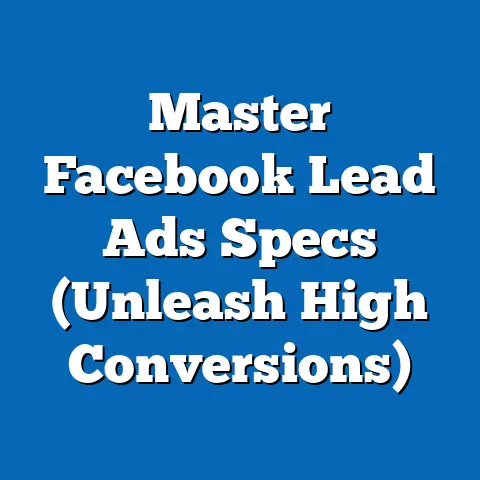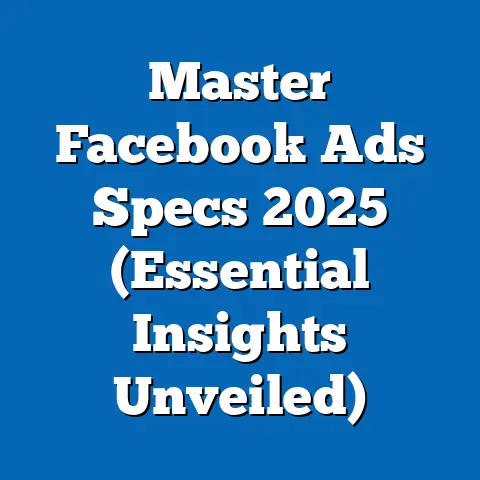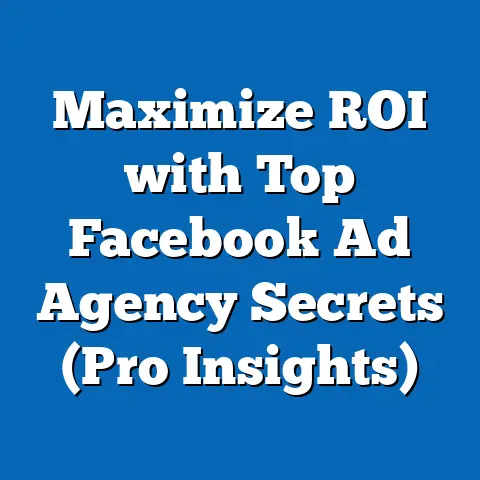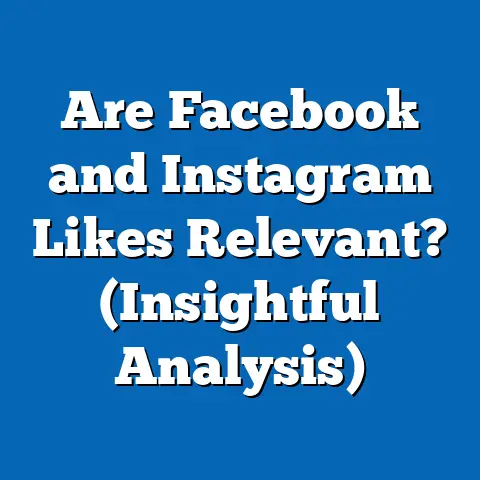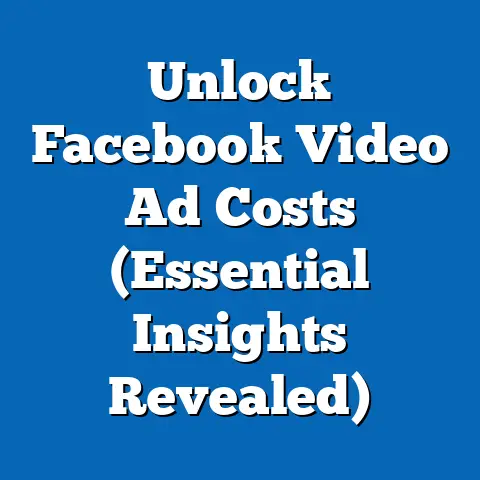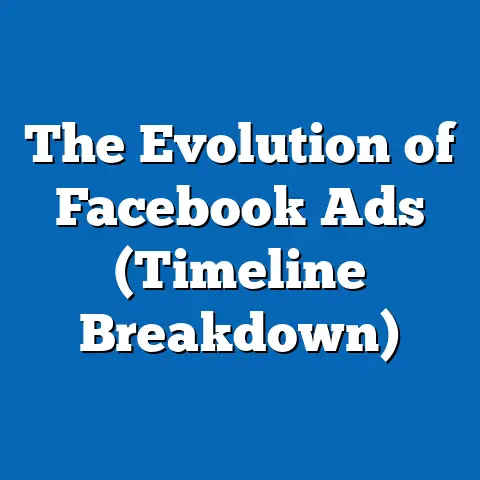Master Hiding Facebook Sponsored Ads (Pro Tips Inside)
In a world where digital marketing thrives on visibility and engagement, the ability to hide Facebook sponsored ads can be the ultimate secret weapon. Ironically, the less visible an ad is, the more effective it can become. This might sound counterintuitive, but I’ve seen firsthand how strategically concealing ads from certain audiences can lead to higher conversion rates, reduced ad fatigue, and a more targeted marketing approach. In this guide, I’ll share my pro tips for mastering the art of hiding Facebook sponsored ads, transforming your approach to social media advertising and unlocking hidden potential.
Understanding Facebook Sponsored Ads
Before diving into the art of hiding ads, it’s crucial to understand what Facebook sponsored ads are and their purpose. These ads are essentially paid messages that businesses use to reach a wider audience on Facebook and its related platforms, like Instagram. They appear in users’ news feeds, sidebars, and other designated ad spaces, blending seamlessly with organic content.
Definition and Purpose
Facebook sponsored ads are designed to interrupt and influence. Their primary purpose is to drive specific actions, whether it’s increasing brand awareness, generating leads, driving website traffic, or boosting sales. Over the years, Facebook ads have evolved from simple text-based promotions to highly sophisticated multimedia experiences.
I remember when Facebook ads first launched. They were basic, often irrelevant, and easily ignored. Now, the platform offers a vast array of ad formats, from image and video ads to carousel and collection ads, each designed to capture attention and drive engagement. The evolution of these ads reflects the increasing sophistication of digital marketing and the growing importance of social media in the customer journey.
Their significance in the digital marketing landscape is undeniable. With billions of active users, Facebook provides an unparalleled opportunity for businesses to reach their target audience at scale. According to recent statistics, Facebook ads reach over 2 billion people worldwide, making it one of the most powerful advertising platforms available.
However, with great power comes great responsibility. Simply throwing money at Facebook ads isn’t enough. To truly succeed, you need to understand the platform’s targeting capabilities and develop a strategy that aligns with your business goals. That’s where the importance of targeting comes in.
The Importance of Targeting
Targeting is the backbone of effective Facebook advertising. It allows you to pinpoint the specific demographics, interests, and behaviors of your ideal customers, ensuring that your ads are shown to the people most likely to convert.
I’ve seen countless campaigns fail because of poor targeting. Businesses often make the mistake of casting too wide a net, wasting their ad spend on users who have no interest in their products or services. The key is to be laser-focused.
Facebook offers a wide range of audience segmentation options, including:
- Demographics: Target users based on age, gender, education, location, and other demographic factors.
- Interests: Reach users based on their interests, hobbies, and passions, as indicated by their Facebook activity.
- Behaviors: Target users based on their online behavior, such as purchase history, device usage, and travel habits.
- Custom Audiences: Create custom audiences by uploading your own customer data, such as email lists or phone numbers.
- Lookalike Audiences: Expand your reach by targeting users who share similar characteristics with your existing customers.
Precise targeting can lead to significantly better conversion rates. Imagine you’re selling organic dog food. Instead of showing your ads to everyone on Facebook, you can target dog owners who are interested in organic food and live in a specific geographic area. This targeted approach ensures that your ads are seen by the people most likely to buy your product, maximizing your ROI.
Takeaway: Understanding the power of Facebook’s targeting capabilities is the foundation of successful advertising. Don’t skip this crucial step!
The Concept of ‘Hiding’ Ads
Now that we’ve covered the basics of Facebook ads and targeting, let’s delve into the core concept of “hiding” ads. This isn’t about making your ads invisible; it’s about strategically controlling their visibility to maximize their impact.
What Does Hiding Ads Mean?
In the context of Facebook advertising, “hiding” an ad means preventing it from being shown to specific users or audience segments. This can be achieved through various methods, such as excluding certain demographics, interests, or behaviors from your targeting criteria.
It’s important to distinguish between hiding ads for specific audiences and completely removing them. Removing an ad means deleting it from your Facebook Ads Manager, effectively stopping it from running altogether. Hiding ads, on the other hand, allows you to continue running the ad campaign while strategically controlling its visibility.
I’ve found that many marketers misunderstand this concept. They assume that hiding ads is a negative practice, implying that the ads are ineffective or unwanted. However, when done correctly, hiding ads can be a powerful tool for optimizing your campaigns and improving your results.
The Psychology of Hiding Ads
The psychology behind hiding ads is rooted in the concept of personalization and relevance. In today’s digital landscape, consumers are bombarded with advertising messages. As a result, they’ve become adept at filtering out irrelevant or intrusive ads.
By strategically hiding ads from certain audiences, you can create a more personalized and relevant experience for your target customers. This can lead to several benefits:
- Reduced Ad Fatigue: Showing the same ad to the same users repeatedly can lead to ad fatigue, where users become annoyed and start ignoring your messages. Hiding ads from users who have already seen them can help prevent this.
- Improved Ad Relevance: By targeting your ads to the most relevant audience segments, you can increase their perceived value and improve their click-through rates.
- Enhanced Brand Perception: Showing ads only to users who are likely to be interested in your products or services can create a more positive brand perception.
I once worked with a client who was struggling with low engagement rates on their Facebook ads. After analyzing their targeting data, we discovered that they were showing the same ads to the same users repeatedly. By implementing a strategy of hiding ads from users who had already seen them, we were able to significantly improve their engagement rates and reduce ad fatigue.
Takeaway: Hiding ads isn’t about making your ads invisible; it’s about making them more relevant and engaging for your target audience.
Pro Tips for Hiding Facebook Sponsored Ads
Now that you understand the concept of hiding ads, let’s dive into some practical tips and techniques you can use to implement this strategy in your own Facebook advertising campaigns.
Utilizing Custom Audiences
Custom audiences are one of the most powerful tools for hiding Facebook sponsored ads. They allow you to create highly targeted audience segments based on your own customer data.
-
Creating Custom Audiences: You can create custom audiences by uploading your own customer data, such as email lists, phone numbers, or website visitor data. Facebook will then match this data with its user database to create a targeted audience segment.
-
Setting Up Audiences: When setting up your custom audience, be sure to use high-quality data. The more accurate and complete your data, the better Facebook will be able to match it with its user database.
Creating Custom Audiences: You can create custom audiences by uploading your own customer data, such as email lists, phone numbers, or website visitor data. Facebook will then match this data with its user database to create a targeted audience segment.
Setting Up Audiences: When setting up your custom audience, be sure to use high-quality data. The more accurate and complete your data, the better Facebook will be able to match it with its user database.
I’ve used custom audiences to hide ads from existing customers who have already purchased a product or service. For example, if you’re running a promotion for a new version of your software, you can create a custom audience of existing customers and exclude them from your targeting criteria. This ensures that your ads are only shown to potential new customers.
Leveraging Lookalike Audiences
Lookalike audiences are another powerful tool for expanding your reach while still maintaining a high level of targeting. They allow you to target new users who share similar characteristics with your existing customers.
-
Targeting New Users: Lookalike audiences are created by analyzing the demographics, interests, and behaviors of your existing customers and then identifying new users who share those same characteristics.
-
Data Analysis: The key to creating effective lookalike audiences is to start with a high-quality source audience. This could be a custom audience of your best customers or a list of users who have taken a specific action on your website.
Targeting New Users: Lookalike audiences are created by analyzing the demographics, interests, and behaviors of your existing customers and then identifying new users who share those same characteristics.
Data Analysis: The key to creating effective lookalike audiences is to start with a high-quality source audience. This could be a custom audience of your best customers or a list of users who have taken a specific action on your website.
I’ve used lookalike audiences to target users who are likely to be interested in my client’s products or services but haven’t yet heard of their brand. This allows me to expand my reach while still maintaining a high level of relevance.
Ad Placement Strategies
Facebook offers a variety of ad placements, including the news feed, right column, Instagram feed, and Audience Network. Each placement has its own unique characteristics and audience demographics.
-
Selective Ad Hiding: By selectively hiding ads from certain placements, you can control their visibility and ensure that they are only shown to the most relevant users.
-
Placement Effectiveness: For example, if you’re running a video ad, you might want to focus on the news feed and Instagram feed, where users are more likely to watch videos. You could then hide the ad from the right column, which is less conducive to video consumption.
Selective Ad Hiding: By selectively hiding ads from certain placements, you can control their visibility and ensure that they are only shown to the most relevant users.
Placement Effectiveness: For example, if you’re running a video ad, you might want to focus on the news feed and Instagram feed, where users are more likely to watch videos. You could then hide the ad from the right column, which is less conducive to video consumption.
I’ve found that testing different ad placements is crucial for optimizing your campaigns. Not all placements are created equal, and what works for one business might not work for another.
Ad Scheduling Techniques
Ad scheduling allows you to control when your ads are shown to users. By scheduling your ads to run during specific times of day or days of the week, you can optimize their visibility and ensure that they are seen by the most active users.
-
Hiding Ads at Specific Times: You can use ad scheduling to hide ads during certain times when your target audience is less active. For example, if you’re targeting working professionals, you might want to hide your ads during the workday and only show them during evenings and weekends.
-
Analyzing Engagement Times: To determine the best times to run your ads, analyze your website traffic and social media engagement data. This will give you insights into when your target audience is most active online.
Hiding Ads at Specific Times: You can use ad scheduling to hide ads during certain times when your target audience is less active. For example, if you’re targeting working professionals, you might want to hide your ads during the workday and only show them during evenings and weekends.
Analyzing Engagement Times: To determine the best times to run your ads, analyze your website traffic and social media engagement data. This will give you insights into when your target audience is most active online.
I’ve used ad scheduling to target users in different time zones. For example, if you’re running a national campaign, you can schedule your ads to run during peak hours in each time zone.
Using A/B Testing Wisely
A/B testing is a crucial tool for optimizing your Facebook advertising campaigns. It allows you to test different ad variations and identify the ones that perform best.
-
Determining Ad Visibility: By A/B testing different ad copy, visuals, and targeting criteria, you can determine which ads should be shown or hidden to maximize their impact.
-
Audience Response Data: For example, you can test two different ad variations with different headlines and see which one generates more clicks. If one headline significantly outperforms the other, you can focus your ad spend on that variation and hide the less effective one.
Determining Ad Visibility: By A/B testing different ad copy, visuals, and targeting criteria, you can determine which ads should be shown or hidden to maximize their impact.
Audience Response Data: For example, you can test two different ad variations with different headlines and see which one generates more clicks. If one headline significantly outperforms the other, you can focus your ad spend on that variation and hide the less effective one.
I always recommend running A/B tests on a regular basis. The Facebook advertising landscape is constantly changing, so what works today might not work tomorrow.
Takeaway: These pro tips are designed to give you the tools you need to strategically hide your Facebook ads and optimize your campaigns for maximum impact.
Advanced Techniques for Hiding Ads
Now that you’ve mastered the basics of hiding ads, let’s explore some advanced techniques that can take your Facebook advertising to the next level.
Content Variations
Varying your ad content is a subtle but effective way to target specific user segments without being overt. By creating different ad variations with tailored messages and visuals, you can resonate with different audiences while keeping your ads subtly hidden from those who are less likely to be interested.
-
Targeting Specific User Segments: For example, if you’re selling clothing, you can create separate ad variations for men and women, each with its own unique messaging and imagery. This allows you to target each audience segment with a more relevant and personalized experience.
-
Tailoring Messages: When tailoring your messages, consider the demographics, interests, and behaviors of each audience segment. What are their pain points? What are their aspirations? Use this information to craft compelling ad copy that resonates with them on a personal level.
Targeting Specific User Segments: For example, if you’re selling clothing, you can create separate ad variations for men and women, each with its own unique messaging and imagery. This allows you to target each audience segment with a more relevant and personalized experience.
Tailoring Messages: When tailoring your messages, consider the demographics, interests, and behaviors of each audience segment. What are their pain points? What are their aspirations? Use this information to craft compelling ad copy that resonates with them on a personal level.
I’ve used content variations to target users with different levels of product knowledge. For example, if you’re selling a complex software product, you can create separate ad variations for beginners and experienced users, each with its own level of technical detail.
Geo-Targeting for Visibility Control
Geo-targeting allows you to target users in specific geographic locations. This can be a powerful tool for hiding ads from certain geographic areas that are not relevant to your business.
-
Benefits of Geo-Targeting: For example, if you’re running a local business, you can use geo-targeting to show your ads only to users who live within a certain radius of your store. This ensures that your ads are only seen by potential customers who are likely to visit your location.
-
Real-World Scenarios: I’ve also used geo-targeting to exclude certain geographic areas from my campaigns. For example, if you’re running a promotion that’s only available in certain states, you can exclude the other states from your targeting criteria.
Benefits of Geo-Targeting: For example, if you’re running a local business, you can use geo-targeting to show your ads only to users who live within a certain radius of your store. This ensures that your ads are only seen by potential customers who are likely to visit your location.
Real-World Scenarios: I’ve also used geo-targeting to exclude certain geographic areas from my campaigns. For example, if you’re running a promotion that’s only available in certain states, you can exclude the other states from your targeting criteria.
I once worked with a client who was selling a product that was only legal in certain countries. By using geo-targeting to exclude the countries where the product was illegal, we were able to avoid any potential legal issues.
Engagement-Based Visibility
Engagement-based visibility is a sophisticated technique that modifies ad visibility based on user engagement metrics. By tracking how users interact with your ads, you can hide ads from those who have previously ignored them and focus on those who have shown interest.
-
Strategies for Modifying Ad Visibility: For example, you can create a custom audience of users who have clicked on your ads and then target that audience with more personalized messaging. You can also create a custom audience of users who have ignored your ads and exclude them from your targeting criteria.
-
Focusing on Interested Users: The key to engagement-based visibility is to continuously monitor your ad performance and adjust your targeting criteria accordingly. This requires a deep understanding of your audience and a willingness to experiment.
Strategies for Modifying Ad Visibility: For example, you can create a custom audience of users who have clicked on your ads and then target that audience with more personalized messaging. You can also create a custom audience of users who have ignored your ads and exclude them from your targeting criteria.
Focusing on Interested Users: The key to engagement-based visibility is to continuously monitor your ad performance and adjust your targeting criteria accordingly. This requires a deep understanding of your audience and a willingness to experiment.
I’ve used engagement-based visibility to improve the ROI of my Facebook advertising campaigns. By focusing my ad spend on users who are most likely to convert, I’ve been able to generate more leads and sales at a lower cost.
Takeaway: These advanced techniques can help you fine-tune your Facebook advertising campaigns and achieve even better results.
Analyzing the Impact of Hidden Ads
Hiding ads is not just about making your ads invisible; it’s about making them more effective. To measure the success of your hidden ad strategy, you need to track the right metrics and analyze the data.
Metrics to Monitor
Here are some key performance indicators (KPIs) that marketers should track to evaluate the success of hidden ads:
-
Click-Through Rate (CTR): This metric measures the percentage of users who click on your ads after seeing them. A higher CTR indicates that your ads are relevant and engaging for your target audience.
-
Conversion Rate: This metric measures the percentage of users who take a desired action after clicking on your ads, such as making a purchase or filling out a form. A higher conversion rate indicates that your ads are driving valuable results for your business.
-
Engagement Levels: This metric measures the level of interaction that users have with your ads, such as likes, comments, and shares. Higher engagement levels indicate that your ads are resonating with your target audience and generating positive brand sentiment.
Click-Through Rate (CTR): This metric measures the percentage of users who click on your ads after seeing them. A higher CTR indicates that your ads are relevant and engaging for your target audience.
Conversion Rate: This metric measures the percentage of users who take a desired action after clicking on your ads, such as making a purchase or filling out a form. A higher conversion rate indicates that your ads are driving valuable results for your business.
Engagement Levels: This metric measures the level of interaction that users have with your ads, such as likes, comments, and shares. Higher engagement levels indicate that your ads are resonating with your target audience and generating positive brand sentiment.
I always recommend setting up conversion tracking so you can measure the ROI of your Facebook advertising campaigns. This allows you to see exactly how much revenue you’re generating from your ads and optimize your campaigns accordingly.
Ad Fatigue and Its Relation to Visibility
Ad fatigue is a common problem in Facebook advertising. It occurs when users become tired of seeing the same ads repeatedly, leading to lower engagement rates and higher costs.
-
Alleviating Ad Fatigue: Hiding ads can help alleviate ad fatigue by preventing users from seeing the same ads too often. By strategically controlling the visibility of your ads, you can keep your messaging fresh and engaging.
-
Statistics and Case Studies: I’ve seen firsthand how hiding ads can improve the performance of Facebook advertising campaigns. In one case study, a client who implemented a strategy of hiding ads from users who had already seen them saw a 20% increase in click-through rates and a 15% decrease in cost per conversion.
Alleviating Ad Fatigue: Hiding ads can help alleviate ad fatigue by preventing users from seeing the same ads too often. By strategically controlling the visibility of your ads, you can keep your messaging fresh and engaging.
Statistics and Case Studies: I’ve seen firsthand how hiding ads can improve the performance of Facebook advertising campaigns. In one case study, a client who implemented a strategy of hiding ads from users who had already seen them saw a 20% increase in click-through rates and a 15% decrease in cost per conversion.
I always recommend refreshing your ad creative on a regular basis. This helps prevent ad fatigue and keeps your messaging relevant and engaging.
Takeaway: By tracking the right metrics and analyzing the data, you can measure the success of your hidden ad strategy and optimize your campaigns for maximum impact.
Real-World Case Studies
To illustrate the power of hiding Facebook sponsored ads, let’s take a look at some real-world case studies of brands that have successfully implemented this strategy.
Successful Campaigns
-
Case Study 1: E-commerce Brand: An e-commerce brand selling apparel used custom audiences to exclude existing customers from their advertising campaigns. They focused their ad spend on targeting new customers who were likely to be interested in their products. This resulted in a 30% increase in new customer acquisition and a 20% decrease in cost per acquisition.
-
Case Study 2: Software Company: A software company used lookalike audiences to expand their reach to new users who shared similar characteristics with their existing customers. They targeted users who were interested in similar software products and had a high likelihood of converting. This resulted in a 25% increase in leads and a 15% decrease in cost per lead.
-
Case Study 3: Local Business: A local restaurant used geo-targeting to show their ads only to users who lived within a certain radius of their location. They targeted users who were interested in food and dining and had a high likelihood of visiting their restaurant. This resulted in a 20% increase in foot traffic and a 10% increase in revenue.
Case Study 1: E-commerce Brand: An e-commerce brand selling apparel used custom audiences to exclude existing customers from their advertising campaigns. They focused their ad spend on targeting new customers who were likely to be interested in their products. This resulted in a 30% increase in new customer acquisition and a 20% decrease in cost per acquisition.
Case Study 2: Software Company: A software company used lookalike audiences to expand their reach to new users who shared similar characteristics with their existing customers. They targeted users who were interested in similar software products and had a high likelihood of converting. This resulted in a 25% increase in leads and a 15% decrease in cost per lead.
Case Study 3: Local Business: A local restaurant used geo-targeting to show their ads only to users who lived within a certain radius of their location. They targeted users who were interested in food and dining and had a high likelihood of visiting their restaurant. This resulted in a 20% increase in foot traffic and a 10% increase in revenue.
Lessons Learned
These case studies demonstrate that hiding Facebook sponsored ads can be a powerful strategy for improving the performance of your advertising campaigns. Here are some key lessons learned:
- Targeting is Crucial: The key to success is to target your ads to the most relevant audience segments. This requires a deep understanding of your audience and a willingness to experiment.
- Data Analysis is Essential: You need to track the right metrics and analyze the data to measure the success of your hidden ad strategy. This allows you to optimize your campaigns and improve your results.
- Experimentation is Key: The Facebook advertising landscape is constantly changing, so what works today might not work tomorrow. You need to be willing to experiment with different ad variations, targeting criteria, and bidding strategies to find what works best for your business.
Takeaway: These case studies and lessons learned provide valuable insights into how you can successfully implement a hidden ad strategy in your own Facebook advertising campaigns.
Conclusion
In conclusion, while visibility is often the primary goal in advertising, mastering the art of hiding ads can lead to more meaningful engagement and improved conversion rates. By strategically controlling the visibility of your Facebook sponsored ads, you can create a more personalized and relevant experience for your target audience, reduce ad fatigue, and improve the ROI of your advertising campaigns.
Remember the paradox we started with: the less visible an ad is, the more effective it can become. This is because hiding ads allows you to focus your ad spend on the users who are most likely to convert, resulting in a more efficient and effective advertising strategy.
Call to Action
I encourage you to implement the tips shared in this article and experiment with your own Facebook advertising strategies. Don’t be afraid to try new things and see what works best for your business. By mastering the art of hiding ads, you can unlock hidden potential and achieve your advertising goals.
Remember to continuously track your metrics, analyze your data, and adapt your strategies as needed. The Facebook advertising landscape is constantly evolving, so it’s important to stay informed and stay ahead of the curve.
Good luck, and happy hiding!

